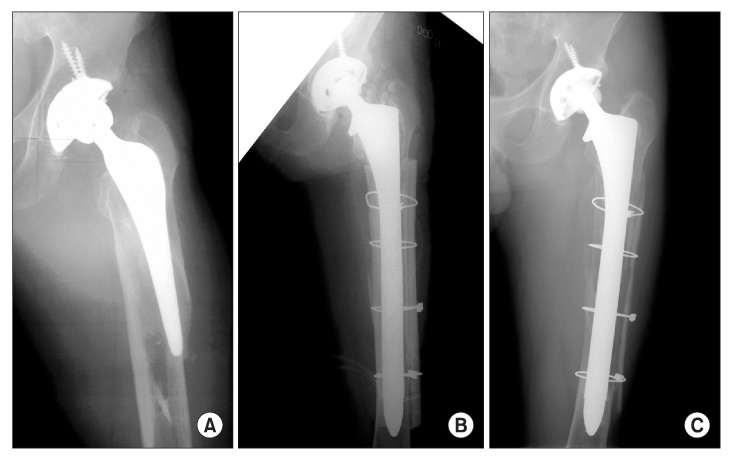Clin Orthop Surg.
2009 Jun;1(2):105-109. 10.4055/cios.2009.1.2.105.
Revision Total Hip Arthroplasty Using an Extensively Porous Coated Femoral Stem
- Affiliations
-
- 1Department of Orthopedic Surgery, College of Medicine, Inha University, Incheon, Korea. moon@inha.ac.kr
- KMID: 1122640
- DOI: http://doi.org/10.4055/cios.2009.1.2.105
Abstract
-
BACKGROUND: To determine the benefit of an extensively porous coated femoral stem in patients receiving revision total hip arthroplasty.
METHODS
This study reviewed the results of 35 patients who received a revision total hip arthroplasty with extensively porous coated femoral stem between August, 1996, and December, 2002. The mean follow-up period was 77.5 months. The clinical and radiological results were evaluated by the Harris hip score and serial roentgenographic findings.
RESULTS
The preoperative and postoperative Harris hip score was 68.3 and 92.5, respectively. Radiographically, none of the acetabular components showed any evidence of migration, tilt, rotation, or shedding of metal particles. In addition, none of the femoral components showed evidence of subsidence, pedestal, or shedding of metal particles. Twenty-two hips had a mild stress shield and 2 hips had a moderate stress shield. The perioperative complications encountered were deep vein thrombosis (1 case), mild heterotopic ossification (4 cases), intraoperative periprosthetic fractures (1 case), and nonunion of the trochanteric osteotomy site (2 cases).
CONCLUSIONS
Extensively porous coated femoral stems and acetabular components produce excellent clinical and radiological results in revision total hip arthroplasty.
MeSH Terms
Figure
Reference
-
1. Ng FY, Chiu KY, Yau WP, Ng TP, Tang WM. Extensively coated femoral components in revision hip arthroplasty: follow-up study of 23 patients. J Orthop Surg (Hong Kong). 2004. 12(2):168–172.
Article2. Huddleston HD. Femoral lysis after cemented hip arthroplasty. J Arthroplasty. 1988. 3(4):285–297.
Article3. Mallory TH. Preparation of the proximal femur in cementless total hip revision. Clin Orthop Relat Res. 1988. (235):47–60.
Article4. Paprosky WG, Burnett RS. Extensively porous-coated femoral stems in revision hip arthroplasty: rationale and results. Am J Orthop. 2002. 31(8):471–474.5. Weeden SH, Paprosky WG. Minimal 11-year follow-up of extensively porous-coated stems in femoral revision total hip arthroplasty. J Arthroplasty. 2002. 17(4):Suppl 1. 134–137.
Article6. Paprosky WG, Burnett RS. Assessment and classification of bone stock deficiency in revision total hip arthroplasty. Am J Orthop. 2002. 31(8):459–464.7. Engh CA, Massin P, Suthers KE. Roentgenographic assessment of the biologic fixation of porous-surfaced femoral components. Clin Orthop Relat Res. 1990. (257):107–128.
Article8. Martell JM, Berdia S. Determination of polyethylene wear in total hip replacements with use of digital radiographs. J Bone Joint Surg Am. 1997. 79(11):1635–1641.
Article9. Engh CA, Bobyn JD, Glassman AH. Porous-coated hip replacement: the factors governing bone ingrowth, stress shielding, and clinical results. J Bone Joint Surg Br. 1987. 69(1):45–55.
Article10. Brooker AF, Bowerman JW, Robinson RA, Riley LH Jr. Ectopic ossification following total hip replacement: incidence and a method of classification. J Bone Joint Surg Am. 1973. 55(8):1629–1632.11. Kavanagh BF, Ilstrup DM, Fitzgerald RH Jr. Revision total hip arthroplasty. J Bone Joint Surg Am. 1985. 67(4):517–526.
Article12. Engh CA, Glassman AH, Griffin WL, Mayer JG. Results of cementless revision for failed cemented total hip arthroplasty. Clin Orthop Relat Res. 1988. (235):91–110.
Article13. Berry DJ, Harmsen WS, Ilstrup D, Lewallen DG, Cabanela ME. Survivorship of uncemented proximally porous-coated femoral components. Clin Orthop Relat Res. 1995. (319):168–177.
Article14. Dohmae Y, Bechtold JE, Sherman RE, Puno RM, Gustilo RB. Reduction in cement-bone interface shear strength between primary and revision arthroplasty. Clin Orthop Relat Res. 1988. (236):214–220.
Article15. Moreland JR, Bernstein ML. Femoral revision hip arthroplasty with uncemented, porous-coated stems. Clin Orthop Relat Res. 1995. (319):141–150.
Article16. Paprosky WG, Magnus RG, Jablonsky WJ. Cementless femoral revision in the presence of severe proximal bone loss using diaphyseal fixation. In : The 60th annual meeting of the AAOS; 1993 Feb; San Francisco, CA.
Article17. Meneghini RM, Hallab NJ, Berger RA, Jacobs JJ, Paprosky WG, Rosenberg AG. Stem diameter and rotational stability in revision total hip arthroplasty: a biomechanical analysis. J Orthop Surg Res. 2006. 1:5.
Article18. Nourbash PS, Paprosky WG. Cementless femoral design concerns: rationale for extensive porous coating. Clin Orthop Relat Res. 1998. (355):189–199.
- Full Text Links
- Actions
-
Cited
- CITED
-
- Close
- Share
- Similar articles
-
- Revision Total Hip Arthroplasty with a Strut Allograft and an Extensively Porous-Coated Femoral Stem
- Revision of Total Hip Arthroplasty Using Extensively Porous-Coated Femoral Stem
- Short Term Results of Cementless Total Hip Arthroplasty With a Tapered Femoral Component
- Mid-term Results of Primary Cementless Total Hip Arthroplasty with a Fiber Metal Taper Femoral Component and Trilogy Acetabular Cup
- Long-Term Results of Total Hip Arthroplasty with an Extensively Porous Coated Stem in Patients Younger than 45 Years Old


